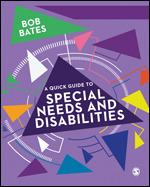A Quick Guide to Special Needs and Disabilities
- Bob Bates - Independent Consultant, UK
Continuing Professional Development | Special & Inclusive Education | Teacher Training
A Quick Guide to Special Needs is an easy go-to guide for busy teachers, SENCOs, practitioners and anyone else who is interested in pragmatic solutions to the challenges of teaching children and young people with additional needs.
Detailing over 60 conditions which cause people to have additional needs, Bob Bates helps you broaden your understanding of different physical, neurological, psychological, and developmental needs with accessible bite-sized explanations of the conditions, best practice approaches to working with these learners, and how to apply them to your everyday teaching.
Each individual need is explained over a 2-page spread and every entry includes:
- Case studies encouraging you to reflect on real-life situations to understand the impact each condition has on people and how they and their parents deal with it.
- Do it steps offering a simple step-by-step approach that you can follow in order to meet additional needs arising out of these conditions.
- Important steps for the classroom specifically for teachers to use.
- Recommended reading, suggesting books, articles and websites where further information on specific conditions are available.
Whether you’re a newly qualified or experienced teacher, or simply want to further your understanding on the vast variety of individual needs, this guide is the ideal dip-in dip-out reference point for SEND.
Also from Bob Bates:
Educational Leadership Simplified
Learning Theories Simplified
Bob Bates’ latest book contains a wealth of information as well as practical ideas, with each one of the 60 or so entries being set out in a similar format, making it easy to dip into and to find what is most relevant to the reader at the time.
Bob writes in a style that is easy to read and quickly catches the interest. I thought his idea of using mini-case studies, including some about people in the public eye not only added interest, but could help those with similar conditions to feel that there are role models who present a positive picture of what can be achieved and that no-one should be defined solely by the difficulties they strive to overcome.’
This is an extremely well researched text that covers detailed descriptions of a wide range of conditions and it would be of great value as a go-to overview of learning differences and interventions, with detailed links to resources.
The book is clearly aimed at teachers, but would also be useful to students and health and social care professionals working with children and young people. It is a valuable starting point for gaining quick and accessible general information in relation to the conditions and issues covered in this book, with a strong theme of inclusion throughout.
A very useful book for our students to springboard their knowledge and understanding of additional needs and disabilities.
This is a really helpful book which encompasses a lot of the key topics covered in the module.
Great book that has snippets of a range of special needs and disabilities. Looking at real life scenarios to enable to put into context the nature of the disability ans needs of the individual
This is an essential introductory guide for students. With the changing nature of HE students it is important to provide clarity and initial foundations of understanding in relation to the key topics we cover. Bob Bates book provides an easy to ready, comprehensive guide to key topics in SEND that are vital to the developing understanding of students new to the area. A must read.
An accessible yet informative text which students considering a placement in a SEND setting would find extremely useful
This gives a valuable insight into some the of issues strategies used to work with learners who have special need or disabilities. The layout is very easy to follow and can allow you to quickly access any information needed. The mini-cases help to give you a variety of views.
This covers a lot of learning difficulties at varying levels and as such is a good resource for SENCO's, Assistant Teachers and Teachers alike; but it should be remembered that the information is written almost in leaflet form, so it is a good starting point .




